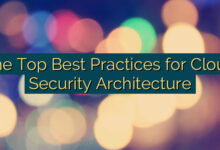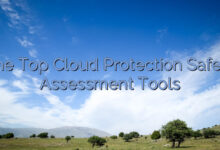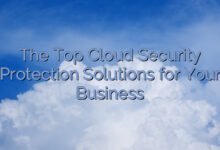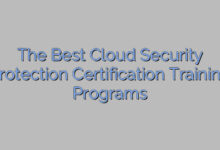The Top Cloud Security Threats and How to Prevent Them
Contents
- 1 Introduction
- 2 The Top Cloud Security Threats and Their Strengths and Weaknesses
- 3 Preventing the Top Cloud Security Threats
- 4 Frequently Asked Questions
- 4.1 1. Are cloud systems safe from cyber threats?
- 4.2 2. How can I monitor my cloud systems for security purposes?
- 4.3 3. Can I store confidential information in the cloud?
- 4.4 4. How often should I conduct security audits on my cloud systems?
- 4.5 5. What should I do in case of a security breach?
- 4.6 6. Should I trust my cloud provider’s security measures?
- 4.7 7. Can I use public cloud services, or should I use private clouds?
- 4.8 8. How can I keep my cloud systems safe from social engineering attacks?
- 4.9 9. Do I need to use multi-factor authentication for my cloud systems?
- 4.10 10. How much should I invest in cloud security?
- 4.11 11. Is it necessary to conduct a security audit before migrating to the cloud?
- 4.12 12. Can I outsource cloud security to a third-party provider?
- 4.13 13. Can I use open-source software for my cloud systems?
- 5 Conclusion
- 6 Closing Words
Introduction
Hello, Visitors! As the world continues to shift towards digital operations, cloud computing has become more prevalent. It is convenient, cost-effective and easily accessible compared to traditional computing systems. However, with all these advantages come security threats that can potentially lead to data theft, cybersecurity breaches, or even financial losses.
In this article, we will delve into the top cloud security threats and how to prevent them. We will explain each threat’s strengths and weaknesses and provide detailed information on how to avoid falling victim to any of them. We will also answer frequently asked questions about cloud security and give you actionable steps to keep you and your data safe.
The Top Cloud Security Threats and Their Strengths and Weaknesses
1. Data Breaches
Data breaches involve unauthorized access to sensitive information and can result in financial loss, identity theft, and other prolonged security risks. One of the strengths of data breaches is their ease of execution; they are often caused by security flaws that a hacker can easily exploit.
To prevent data breaches, you can implement encryption, multi-factor authentication, and regular security audits. Ensure that you only store necessary information and delete all unessential data.
2. Insider Threats
Insider threats refer to the risks posed by individuals who have access to your cloud systems. These individuals could be employees, ex-employees, or third-party vendors. Due to their trusted positions, they can easily access, steal or manipulate data.
One way to combat insider threats is by implementing access restrictions and monitoring any unusual activities or behavior by these individuals. You can also ensure that all equipment and data used by terminated employees are retrieved, as they no longer have permission to access the system.
3. Malware
Malware refers to any software designed to harm your computer systems or network. It can infect your cloud infrastructure by spreading through email attachments, phishing links, or unsecured software downloads.
To prevent malware, install anti-virus and anti-malware software, implement firewall protections, and ensure that all devices and software used are up-to-date with the latest security patches. Educate your employees on safe browsing habits and avoid visiting unverified websites or downloading unsecured software.
4. DDoS Attacks
A Distributed Denial of Service (DDoS) attack is a type of cybercrime where a network is flooded with traffic from different sources, causing it to crash or slow down and making it inaccessible to legitimate users.
To prevent DDoS attacks, implement strong access controls, update firmware, and ensure that you have back-up systems that can handle unexpected traffic surges. Regularly check your network for any anomalies that may be a sign of a DDoS attack.
5. Physical Security
Physical security threats refer to unauthorized access to your cloud systems or hardware. Such breaches can include theft, tampering with equipment, or even natural disasters such as fire or floods.
One way to prevent physical security breaches is by restricting access to authorized personnel only, such as security personnel or IT staff who can monitor the hardware. You can also install security cameras, alarms, and implement environmental monitoring systems to protect against disasters.
6. Unsecured Interfaces and APIs
An Application Programming Interface (API) is a software intermediary that allows two applications to communicate with each other. While APIs enhance interconnectivity, they can be exploited by attackers to gain access to your cloud systems.
To prevent unsecured APIs, use only trusted and secure APIs and interfaces. Regularly test your APIs’ security to ensure that they have the necessary encryption, access controls, and security measures.
7. Misconfiguration and Human Error
Misconfiguration occurs when systems are set up or updated incorrectly, leading to vulnerabilities. Human error is a common cause of misconfiguration and can result from inadequate training, lack of knowledge, or carelessness.
To prevent misconfiguration and human errors, ensure your employees have proper training and have access to configuration guidelines. Regularly check for security updates and implement backups to avoid losing critical data in the event of an error.
Preventing the Top Cloud Security Threats
Below are some actionable steps you can take to protect your cloud infrastructure from the top security threats.
| Threat | Prevention Strategies |
|---|---|
| Data breaches | Encryption, multi-factor authentication, regular security audits |
| Insider threats | Access restrictions, monitoring, retrieve hardware from terminated employees |
| Malware | Anti-virus & anti-malware software, regular security patches, safe browsing habits |
| DDoS Attacks | Strong access controls, back-up systems, regular network checks |
| Physical security | Restricting access, security cameras & alarms, environmental monitoring systems |
| Unsecured interfaces and APIs | Use trusted & secure APIs, regular security testing & encryption |
| Misconfiguration & human error | Regular training, access to configuration guidelines, regular security backups & checks |
Frequently Asked Questions
1. Are cloud systems safe from cyber threats?
Cloud systems are as safe as you make them. Proper security measures such as encryption, multi-factor authentication, and regular audits can protect you from cyber threats.
2. How can I monitor my cloud systems for security purposes?
You can use tools such as cloud security posture management (CSPM) and Security Information and Event Management (SIEM) to monitor your cloud systems for any security threats.
3. Can I store confidential information in the cloud?
Yes, you can store confidential information in the cloud with proper encryption measures, access controls, and security procedures in place.
4. How often should I conduct security audits on my cloud systems?
You should conduct security audits on your cloud systems at least once a year and after any major system changes or updates.
5. What should I do in case of a security breach?
You should have an incident response plan to guide you in case of a security breach. The plan should include procedures for identifying, containing, and eradicating the breach.
6. Should I trust my cloud provider’s security measures?
You should review your provider’s security measures regularly to ensure they are up-to-date and compatible with your business needs. You are responsible for the safety of your data, so don’t solely rely on your provider’s security.
7. Can I use public cloud services, or should I use private clouds?
It depends on your business’s needs and security requirements. Public cloud services are convenient and cost-effective, while private clouds offer more control and customization. Ensure that the cloud service provider you choose meets your security requirements.
Educate your employees on social engineering attacks and how to detect and prevent phishing attacks. You can also implement two-step verification processes to avoid unauthorized access to your systems.
9. Do I need to use multi-factor authentication for my cloud systems?
Yes, Multi-Factor authentication adds an extra layer of security by requiring users to provide more than one form of authentication to access systems.
10. How much should I invest in cloud security?
You should invest enough in cloud security to sufficiently protect your data and systems. The investment will vary depending on the size of your business and the type of information you store.
11. Is it necessary to conduct a security audit before migrating to the cloud?
Yes, conducting a security audit before migration can identify any vulnerabilities and help you implement necessary security measures before it’s too late.
12. Can I outsource cloud security to a third-party provider?
Yes, you can outsource cloud security to third-party providers. Ensure that you choose a trusted and certified security provider to avoid data breaches and cybersecurity threats.
13. Can I use open-source software for my cloud systems?
You can use open-source software for your cloud systems, but ensure that it is vetted and audited for security vulnerabilities.
Conclusion
Cloud security threats can cause significant disruptions, data loss, and financial implications for your business. However, with the necessary precautions and security measures in place, you can keep your cloud systems safe from such threats.
To recap, we discussed the top cloud security threats, their strengths, and weaknesses, and the actionable steps to prevent them. We answered frequently asked questions about cloud security and provided tips on keeping your cloud systems safe. We encourage you to implement these security measures and review them regularly to ensure that your cloud environment remains safe and secure.
Closing Words
We hope that this article has been helpful in educating you on cloud security threats and the importance of securing your cloud systems. Remember to stay vigilant and proactive in protecting your cloud infrastructure. Lastly, the information provided in this article is for informational purposes only and should not substitute for professional advice on cloud security.







